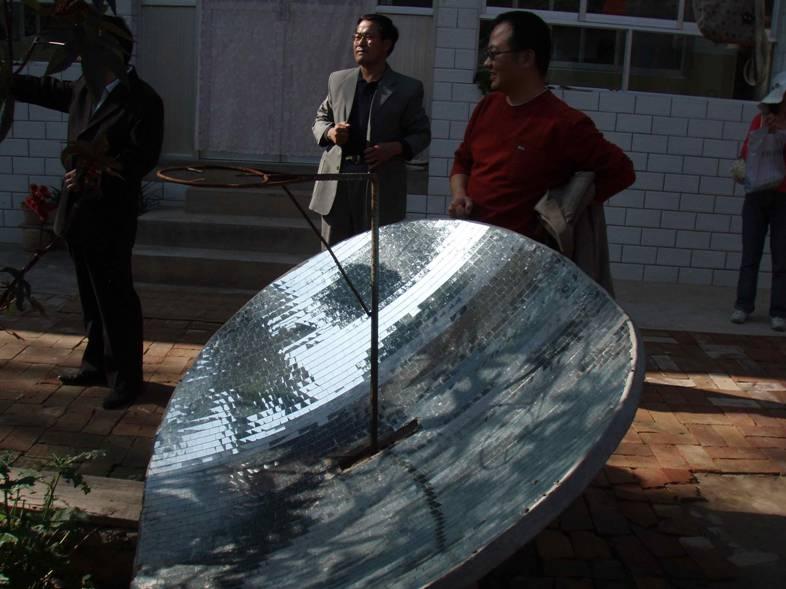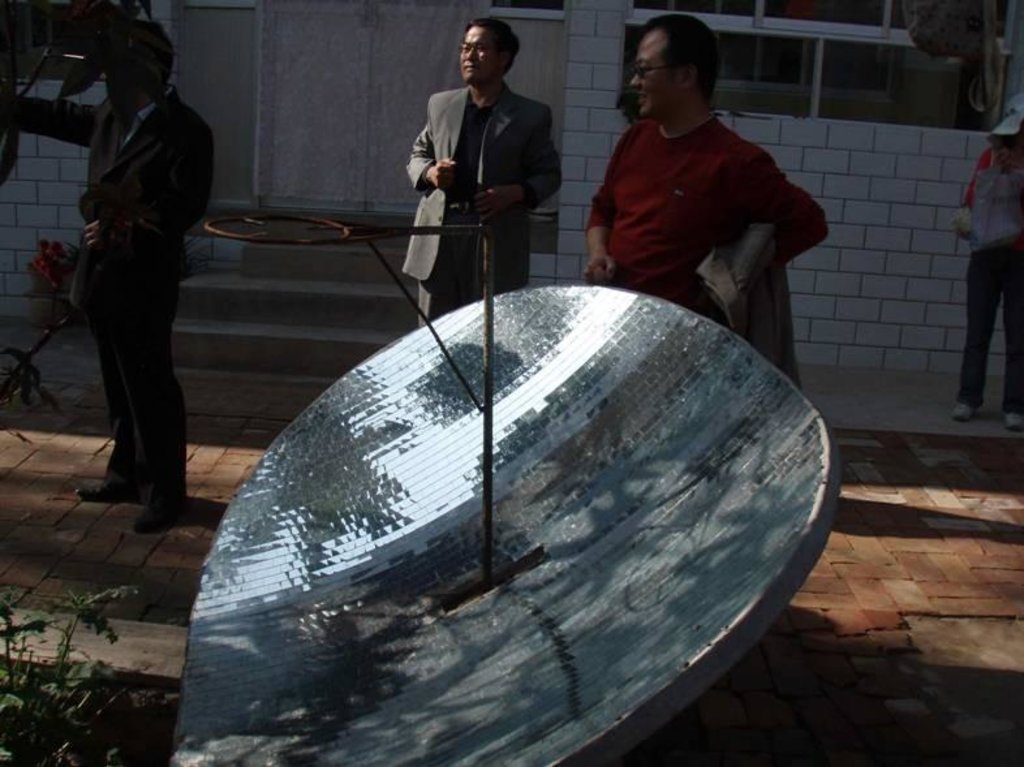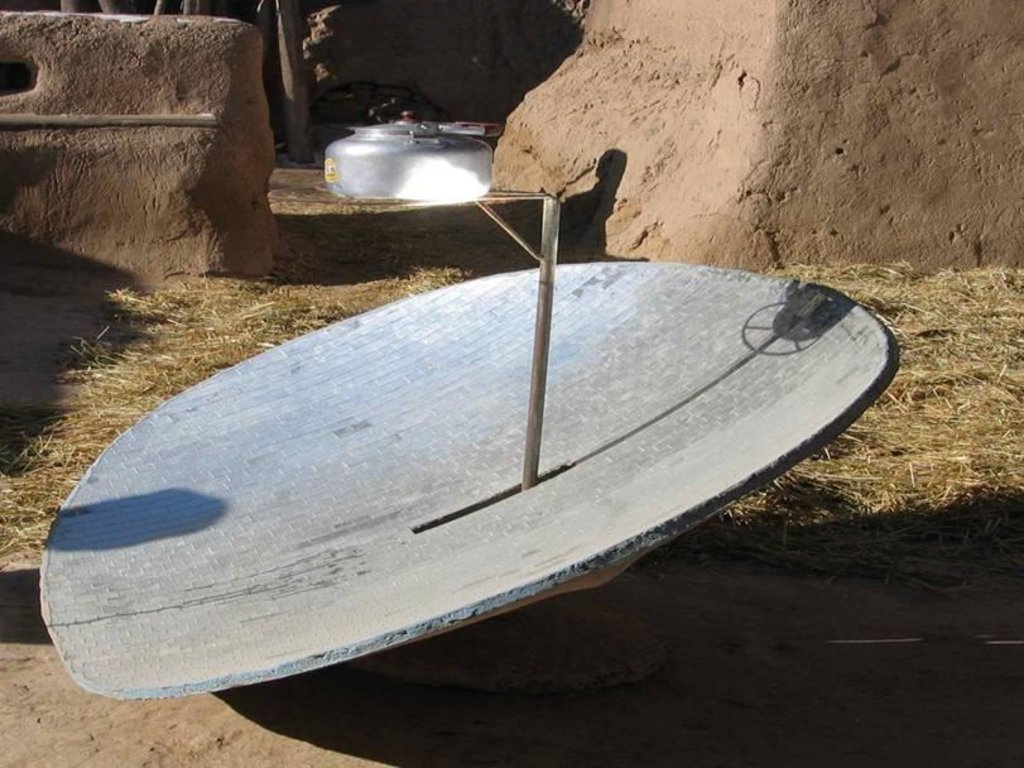Solar Stove for Rural Communities [China]
- Creation:
- Update:
- Compiler: Anna Schuler
- Editor: –
- Reviewer: Laura Ebneter
approaches_2433 - China
View sections
Expand all Collapse all1. General information
1.2 Contact details of resource persons and institutions involved in the assessment and documentation of the Approach
SLM specialist:
Zhang Peng
0971-6365120
zhp1218001@163.com
Qinghai Provincial Forestry Bureau
No.25, Xichuannanlu Road, Xining, Qinghai, postcode 810008
China
Name of the institution(s) which facilitated the documentation/ evaluation of the Approach (if relevant)
Qinghai Provincial Forestry Bureau - ChinaName of the institution(s) which facilitated the documentation/ evaluation of the Approach (if relevant)
CDE Centre for Development and Environment (CDE Centre for Development and Environment) - Switzerland1.3 Conditions regarding the use of data documented through WOCAT
The compiler and key resource person(s) accept the conditions regarding the use of data documented through WOCAT:
Yes
2. Description of the SLM Approach
2.1 Short description of the Approach
Solar stoves use solar energy for cooking, featuring environmental-friendly, zero pollution, low cost, easy operation and maintenance, safe and convenient use, saving firewood, etc. To operate the stove, adjust condenser aiming at the sun with the spot on stove or other objects to be heated.
2.2 Detailed description of the Approach
Detailed description of the Approach:
Qinghai has high elevation, with intense and long sunshine to suit dissemination of the technology to compensate for the shortage of fuel in the countryside, effectively reducing the labor in wood/grass cutting and vegetation destruction, protecting the environment and promoting soil degradation control. Therefore the technology has significant ecological and social benefits.
Restrictions in use: it can only be operated when sunlight is available; operation requires manual adjustment of aim from time to time (lack of sunlight auto-tracking technology application) resulting in an operative time efficiency of about 40%. Solar stove dissemination is financed by the government with labor input by farmers and herdsmen. International financial aid is utilized as an effective incentive for implementation. Publicity and demonstration were conducted to attract more families to use solar stoves. Farmers are the users and beneficiaries so that training to them on operation and maintenance should be conducted.
In 2005, the solar stove dissemination started and so far 150 units have been in operation representing 28% of total demonstration households. Satisfactory results have been achieved. At present, Qinghai provincial government provides special financial support to the dissemination of solar stove extension so the technology application has a bright prospect.
2.3 Photos of the Approach
2.5 Country/ region/ locations where the Approach has been applied
Country:
China
Region/ State/ Province:
Qinghai Province
Further specification of location:
Shazhuyu pilot of Gonghe County
2.6 Dates of initiation and termination of the Approach
Indicate year of initiation:
2005
2.8 Main aims/ objectives of the Approach
Aims of the approach are to: - form the technology dissemination mechanism that integrates related organizations; - carry out environmental awareness education and raise community participation level; - develop technical training to raise the community's capability in ecological protection; - use alternative energy to solve the rural fuel insufficiency problem and to alleviate the pressure on the environment; - Protect and increase vegetation cover and improve ecological conditions
The SLM Approach addressed the following problems: - lack of fuel and firewood cutting damage vegetations in the rural area; - serious soil and water erosion ; - topsoil losses; - decline of soil fertility.
2.9 Conditions enabling or hindering implementation of the Technology/ Technologies applied under the Approach
availability/ access to financial resources and services
- hindering
Farmer households are poor and short of funds
Treatment through the SLM Approach: Government provides financial support with counterpart funds from households. Access to international assistance.
knowledge about SLM, access to technical support
- hindering
The technology is not mature. Most solar stoves are artificially operated unable of tracking automatically the sun. Weather condition may also affect the use efficiency.
Treatment through the SLM Approach: Research and developemnt to resolve the technical problems and reduce the cost.
3. Participation and roles of stakeholders involved
3.1 Stakeholders involved in the Approach and their roles
- local land users/ local communities
- national government (planners, decision-makers)
3.2 Involvement of local land users/ local communities in the different phases of the Approach
| Involvement of local land users/ local communities | Specify who was involved and describe activities | |
|---|---|---|
| initiation/ motivation | external support | Accept education of solar energy technology |
| planning | interactive | The participatory planning on solar stove extension |
| implementation | external support | Use and disseminate solar stoves |
| monitoring/ evaluation | interactive | Monitoring and evaluation of the solar stove application |
| Research | none |
3.4 Decision-making on the selection of SLM Technology/ Technologies
Explain:
experts of rural new energy use/ecological protection experts /project implementation organizer/ government poverty reduction office
4. Technical support, capacity building, and knowledge management
4.1 Capacity building/ training
Was training provided to land users/ other stakeholders?
Yes
Specify who was trained:
- land users
Form of training:
- demonstration areas
Subjects covered:
The training includes solar stove installation, operation and maintenance is conducted in form of site demonstration; The effect of training to households especially the training to woman is acceptable.
4.3 Institution strengthening (organizational development)
Have institutions been established or strengthened through the Approach?
- yes, moderately
Specify the level(s) at which institutions have been strengthened or established:
- local
Specify type of support:
- financial
Give further details:
Application of the technology changes the villager's energy consumption manner, with decreased expenditure and increased income. Therefore it is helpful for poverty reduction and environmental protection. The extension also promoted the capacity building of local forestry organizations.
4.4 Monitoring and evaluation
Is monitoring and evaluation part of the Approach?
Yes
Comments:
bio-physical aspects were monitored through measurements; indicators: Site measure the light application time and illumination intensity
technical aspects were monitored through measurements; indicators: Hours of soalr stove use (the use rate). Estimate the quantity of firewood saving.
socio-cultural aspects were monitored through measurements; indicators: Survey the villagers acceptance to the technology and comments from women
economic / production aspects were monitored through measurements; indicators: Calculate the economic value equivalent to standard coal.
area treated aspects were monitored through measurements; indicators: Survey the number of household users
management of Approach aspects were monitored through measurements; indicators: Survey regularly the household users, monitor and evaluate their feedback information
There were changes in the Approach as a result of monitoring and evaluation: Adopt the participatory type and not the administrative type of extension approach.
4.5 Research
Was research part of the Approach?
Yes
Specify topics:
- technology
Give further details and indicate who did the research:
Undertaken by the solar research institutions and on the topics of solar stove automatic tracking, energy storage, new building materials, raising utilization efficiency etc.
5. Financing and external material support
5.1 Annual budget for the SLM component of the Approach
Comments (e.g. main sources of funding/ major donors):
Approach costs were met by the following donors: government: 90.0%; local community / land user(s): 10.0%
5.2 Financial/ material support provided to land users
Did land users receive financial/ material support for implementing the Technology/ Technologies?
Yes
5.3 Subsidies for specific inputs (including labour)
- equipment
| Specify which inputs were subsidised | To which extent | Specify subsidies |
|---|---|---|
| solar stove | fully financed | covered by government |
Comments:
labor of transportation of solar stove is solved by farmer households.
5.4 Credit
Was credit provided under the Approach for SLM activities?
No
6. Impact analysis and concluding statements
6.1 Impacts of the Approach
Did the Approach help land users to implement and maintain SLM Technologies?
- No
- Yes, little
- Yes, moderately
- Yes, greatly
Investigate the conditions of vegetation cover increase, soil and water erosion reduction in the technology application areas.
Did other land users / projects adopt the Approach?
- No
- Yes, little
- Yes, moderately
- Yes, greatly
The technology has also been adopted in other areas and other projects.
6.4 Strengths/ advantages of the Approach
| Strengths/ advantages/ opportunities in the compiler’s or other key resource person’s view |
|---|
| The top-down extension is effective (How to sustain/ enhance this strength: raise the capacity of the governmental organization ) |
| farmers further spread the technology among themselves by observation and visits (How to sustain/ enhance this strength: enhance the training and extension) |
| farmers benefit through reduced expenditure in energy (How to sustain/ enhance this strength: use meanwhile other clean energy forms) |
6.5 Weaknesses/ disadvantages of the Approach and ways of overcoming them
| Weaknesses/ disadvantages/ risks in the compiler’s or other key resource person’s view | How can they be overcome? |
|---|---|
| backward economy affect the extension speed | strengthen project support |
| sole financing channel for the technology | form co-financing arrangement of government, individuals and international donors |
7. References and links
7.1 Methods/ sources of information
- field visits, field surveys
- interviews with land users
Links and modules
Expand all Collapse allLinks
No links
Modules
No modules




